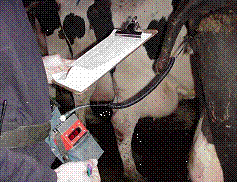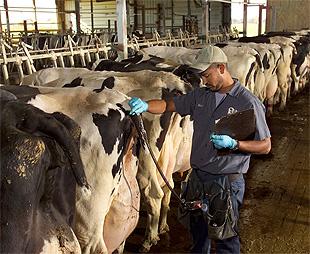What was recently a new dairy management practice is now a standard operating procedure on most large dairies. Since the late ‘90’s, intensive fresh-cow monitoring programs have grown tremendously in popularity across the USA.
Once dairies start routine fresh-cow monitoring, very few ever stop, because the benefits are easily observed. Benefits include:
- Early detection of potentially serious or even deadly diseases
- Protection of cows as they enter their most productive and profitable stage of lactation
- Prevention of future reproductive problems
- Fewer secondary diseases like displace abomasums (DAs) and ketosis because cows are identified and treated before they go off feed
- Reduced culling and death loss in the first 60 days of lactation.
Why use a digital thermometer?
Our goal of course is to take the cows temperature. On small farms where there are only a few cows in the fresh pen, a regular or “conventional” thermometer may suffice. However, when farms grow larger to 500, 1000, or more, the fresh pen becomes much larger and much more intense; However, the same work must be done in the same timeframe. A general rule of thumb in fresh cow protocols is to do all necessary tasks in the fresh pen in less than an hour. This generally includes:
- Identification
- Temperature
- Diagnosis
- Treatment
- Movement
Most large successful dairies have a strict “1 hour rule”. Simply put, cows are not locked up for more than an hour.
 So, work must be done as precisely and efficiently as possible. The digital thermometer allows the user to read results much faster and much more accurately. Comparison : So, work must be done as precisely and efficiently as possible. The digital thermometer allows the user to read results much faster and much more accurately. Comparison :
- Conventional thermometer: 45 - 60 seconds / cow
- Digital thermometer: 5 - 10 seconds / cow
- Conventional thermometer: often hard to read and often not read correctly
- Digital thermometer: much easier to read, consistent accurate results
There are several types of thermometers used, but the most popular and common among large dairies, is the M700 large dairy thermometer. It is durable, easy to read, accurate, and fast. Although it is a more expensive than others, most dairy producers will tell you it pays for itself within the first month.
Making the Most of Temping Time
 According to Dr. Jerry Olson, DVM, MS, DACT, Pfizer Animal Health, there are several variations in the fresh-cow protocols that veterinarians recommend, however, the fundamental practice essential to a successful program is taking the rectal temperatures of every fresh cow for the first 10 days postpartum. Skipping this step or cutting the number of temping days short will result in missed fevers and less-than-optimal results from the program. According to Dr. Jerry Olson, DVM, MS, DACT, Pfizer Animal Health, there are several variations in the fresh-cow protocols that veterinarians recommend, however, the fundamental practice essential to a successful program is taking the rectal temperatures of every fresh cow for the first 10 days postpartum. Skipping this step or cutting the number of temping days short will result in missed fevers and less-than-optimal results from the program.
The 5-10 seconds invested in temping every cow can be put to good productive use making other health assessments that should be performed anyway, therefore, making efficient use of your time. While the thermometer is in the cow, the technician can also observe the following 4 things:
- Lungs: Assess breathing and respiratory rate, to determine if the cow is breathing more rapidly than herdmates. If so, a follow-up examination of lung sounds with a stethoscope may be needed.
- Rumen Fill: Look over the cow's back from the rear view to assess rumen fill. If the rumen does not meet the last rib and the cow appears gaunt or hunched up, she may be off feed and/or have a DA.
- Uterus: Check for vaginal discharge and retained placenta. Cows with retained placenta more than 3 days are candidates for possible therapy.
- Normal vaginal discharge in fresh cows is relatively thick with no unpleasant odor, and can range from bright red to chocolate brown.
- Abnormal discharge, signaling a metritis infection, is reddish, watery and has a foul, fetid odor.
- Udder: Examine the udder for asymmetrical quarters that could indicate a mastitis infection. If one or more quarters appears enlarged, check the quarters for abnormal secretions (flakes, clots or watery milk) indicating mastitis
With a little practice, these 4 steps can be done very quickly, and by the time a digital thermometer registers a cow's temperature, 5-10 seconds, the rest of a fresh cow's diagnostic work-up usually can be completed. The thermometer's reading, together with the other information gathered, will point to the final diagnosis and course of therapy necessary for that animal or a need for a closer examination.
Diagnostic Decisions
The best possible outcome is a normal temperature with no other physical symptoms. Those cows require no treatment and are allowed to remain with the fresh group for daily evaluation until their 10 days have passed.
Ideally, temperatures should be taken early in the day before hot environmental temperatures cause an increase in the rectal temperature of even normal, healthy cows. But a temperature of 103 to 103.5 F or above signals fever, in which case other factors need to be considered to make an accurate diagnosis.
Milk fever (hypocalcaemia) usually can be ruled out in cases of feverish cows. While cows with milk fever are obviously sick, they typically exhibit normal or lower-than-normal body temperature, because they lose ability to regulate temperature. In the early stages of milk fever, cows may shiver, shift their weight, and appear weak and droopy. Recommended courses of therapy for milk fever vary, but they all include some form of calcium. These cows do not need antibiotics.
So the presence of a fever almost always points to one of the other three primary fresh-cow diseases: Pneumonia, Mastitis or Metritis.
Pneumonia usually is diagnosed as a result of:
- Fever
- Rapid, shallow breathing
- Abnormal lung sounds
Antibiotic treatment based on farm protocols for pneumonia..
Mastitis diagnosis: - (based on fever)
- Fever
- Abnormal mammary appearance and/or secretions (flakes, clots or watery milk)
Treatment based on farm protocols for mastitis.
Metritis
 If pneumonia and mastitis are ruled out in a cow with an elevated body temperature, the infection causing the fever is almost always metritis. A cow in the early stages of metritis may appear healthy and show no clinical signs except for a fever, yet still have an infection raging in her uterus. That is why daily temping in the first 10 postpartum days is so critical. If pneumonia and mastitis are ruled out in a cow with an elevated body temperature, the infection causing the fever is almost always metritis. A cow in the early stages of metritis may appear healthy and show no clinical signs except for a fever, yet still have an infection raging in her uterus. That is why daily temping in the first 10 postpartum days is so critical.
In cases where there are no obvious indications of an abnormal uterine discharge, the character of uterine discharge can be determined by doing a rectal exam and milking uterine fluid out of the vagina.
The postpartum uterus is a mixed bag of bacterial organisms that are present following calving. While a laboratory culture of postpartum uterine fluid may sound like a more precise means of diagnosing metritis, it has been proven to not be reliable because of the heavy uterine bacterial loads in every fresh cow, even the healthiest ones.
Once the diagnosis of metritis has been made, antibiotics such as:
- Penicillin
- Penn-strep
- Poly-flex
- Excenel RTU
Can be administered. Excenel RTU has repeatedly been shown to very effectively treat metritis-causing bacteria, while allowing cows to produce salable milk because it has no required milk discard when used according to label and it can be injected only once a day. However, Penicillin is the cheaper drug of choice but has a 96 hour withholding and needs injected every 12 hours to be as effective (twice a day am-pm). |